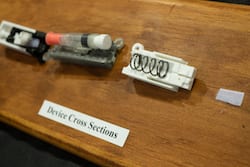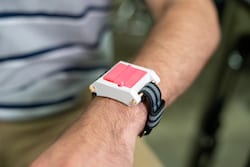NEWS RELEASE
Editor’s note: Links to video and high-resolution images for download appear at the end of this release.
David Ruth
713-348-6327
david@rice.edu
Mike Williams
713-348-6728
mikewilliams@rice.edu
Rice students work up wearable to halt allergic reactions
Engineering team prototypes EpiWear to keep emergency medication at hand at all times
HOUSTON – (April 18, 2019) – What if, in an emergency, you reach for your epinephrine shot and it’s not there? It would be if you were wearing it.
Rice University students have designed a small, foldable epinephrine delivery device meant to be worn on a wrist, like a watch, or elsewhere on the body by a person at risk of an allergic reaction that requires an immediate response.
The trifold device they call EpiWear has a unique, spring-activated injection system that would provide a full dose of the drug to a person experiencing an allergic reaction.
The team – junior bioengineering majors Albert Han, Alex Li, Jacob Mattia and Justin Tang, and freshman Callum Parks – said the device is intended for all but small children, and could be a good alternative to other delivery systems on the market.

Rice University engineering students have prototyped a wearable epinephrine delivery device for people at risk of serious allergic reactions that require a quick shot. The trifold device, seen in a larger version here, will make it easier for people to keep with them if needed quickly. Photo by Brandon Martin
“The idea came from me, because I suffer peanut allergies,” said Tang, who worked on the device at the Brown School of Engineering’s Oshman Engineering Design Kitchen with adviser and Rice lecturer Deirdre Hunter. “I’m very self-aware and worried about my life, but it was always difficult for me to bring something as bulky and obtrusive as this when going to dinner with friends or just going out at night.”
Tang held up the penlike syringe he carries in case of emergency. Such pens were the focus of controversy a few years ago when Congress held a hearing on the sharply rising price of the devices.
The Rice team hopes its creation will lead to a delivery device that is less expensive, more stylish and thus more likely to be worn by users.
“We designed the optimal device to house the minimal amount of epinephrine necessary for injection,” Mattia said, holding a scaled-up prototype.
EpiWear is designed to inject a dose of 0.3 milliliters of epinephrine, the same as commercial devices that contain more of the drug.
“They actually only inject a fraction of what they hold,” Li said.
When unfolded, the hinged device will be about the same length as the epinephrine pens on the market now, with the dose in the middle section and a strong spring in the top. Releasing a safety lever will allow the user to push a cap on top that, in the prototype, cuts a line and releases the spring, plunging the syringe into the user’s thigh.
Along with the lever, Li said the nature of the trifold is itself a safety feature.

A breakdown shows the internal mechanism of an epinephrine delivery device prototyped by Rice University engineering students. Photo by Jeff Fitlow
“None of the compartments are linear, so the needle would be in one compartment while the spring is in another,” he said. “Even if the spring were to go off accidentally, it wouldn’t be able to push the needle.
“We also plan to have a case that goes around the whole device that will prevent the button from hitting anything and allow you to wear it comfortably without risk of triggering it accidently,” Li said.
They realize, too, that a fashionable EpiWear is more likely to be worn.
“There has been research on which patients carry pens and which don’t,” Mattia said. “We’ve been focusing on the mechanism itself, but some of the ideas we’ve thought about are designing it with cool colors or integrating a watch to make it a dual-purpose device.
“If it’s something that’s going to save your life, we think that would be enough to persuade people to maintain it on their bodies,” Li said. “At the end of the day, it’s better to have it on you.”

Team EpiWear, from left: Alex Li, Justin Tang, Jacob Mattia, Albert Han and Callum Parks. Photo by Jeff Fitlow
-30-
Visit the team’s public webpage at http://oedk.rice.edu/Sys/PublicProfile/49192230/1063096.
Follow Rice News and Media Relations via Twitter @RiceUNews.
Related materials:
George R. Brown School of Engineering: https://engineering.rice.edu
Oshman Engineering Design Kitchen: http://oedk.rice.edu
Video:

Video produced by Brandon Martin/Rice University
Images for download:
https://news2.rice.edu/files/2019/04/0422_EPIWEAR-1-web-qvpxqz.jpg
Rice University engineering students have prototyped a wearable epinephrine delivery device for people at risk of serious allergic reactions that require a quick shot. The trifold device, seen in a larger version here, will make it easier for people to keep with them if needed quickly. (Credit: Brandon Martin/Rice University)
https://news2.rice.edu/files/2019/04/0422_EPIWEAR-2-web-16tyeap.jpg
A breakdown shows the internal mechanism of an epinephrine delivery device prototyped by Rice University engineering students. (Credit: Jeff Fitlow/Rice University)
https://news2.rice.edu/files/2019/04/0422_EPIWEAR-3-web-11m8o13.jpg
The goal of a team of Rice University students is to create a wearable epinephrine delivery device that people prone to allergic reactions can keep on them and handy at all times. Larger prototypes served as the proof-of-concept that a spring-loaded, trifold device can effectively deliver a full dose of epinephrine. (Credit: Brandon Martin/Rice University)
https://news2.rice.edu/files/2019/04/0422_EPIWEAR-4-web-1bkmp9u.jpg
Rice University students calling themselves Team EpiWear prototyped a wearable epinephrine delivery device for people at risk of serious allergic reactions. From left: Alex Li, Justin Tang, Jacob Mattia, Albert Han and Callum Parks. (Credit: Jeff Fitlow/Rice University)
Located on a 300-acre forested campus in Houston, Rice University is consistently ranked among the nation’s top 20 universities by U.S. News & World Report. Rice has highly respected schools of Architecture, Business, Continuing Studies, Engineering, Humanities, Music, Natural Sciences and Social Sciences and is home to the Baker Institute for Public Policy. With 3,962 undergraduates and 3,027 graduate students, Rice’s undergraduate student-to-faculty ratio is just under 6-to-1. Its residential college system builds close-knit communities and lifelong friendships, just one reason why Rice is ranked No. 1 for lots of race/class interaction and No. 2 for quality of life by the Princeton Review. Rice is also rated as a best value among private universities by Kiplinger’s Personal Finance.





